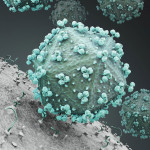In the latest of a string of major setbacks in the search for an HIV vaccine, researchers have shuttered a trial after the experimental vaccine failed to both prevent HIV transmission and to reduce viral load in those who contracted the virus, the Los Angeles Times reports. The National Institute of Allergy and Infectious Diseases (NIAID), a branch of the National Institutes of Health (NIH), ordered all sites to cease immunizations after an independent review board ascertained that more people receiving the vaccine became infected with HIV than those receiving the placebo—although this difference was not statistically significant and may have been a result of chance.
Called HVTN 505, the Phase IIb study was conducted by the NIAID-supported HIV Vaccine Trials Network (HVTN). It began in 2009 and enrolled 2,504 men who have sex with men (MSM) and transgendered people who have sex with men in 21 sites in 19 U.S. cities. The vaccine built on the moderate success of the a vaccine called RV-144 that reduced infection rates among heterosexuals in Thailand by 30 percent, but which was shut down in 2009 because its protection rate was still not high enough. The vaccine was designed to induce an immune response against all three subtypes of the virus.
Among the 1,250 participants who received the experimental vaccine in the latest trial, 41 became HIV positive during the study, while among the 1,244 receiving the placebo, 30 participants contracted the virus. During the first 28 weeks of the study, 23 participants became infected with HIV, including 15 who received the vaccine and nine who received the placebo. The NIAID stated in a release that further analysis is needed to determine if the increased proportion of infections in the active agent group were a result of chance.
The vaccine also failed to reduce the viral load of those who became HIV positive during the trial.
In a release statement, NIAID asserted that it “remains committed to the pursuit of a highly effective, preventive HIV vaccine as part of a multifaceted HIV prevention research program.”
To read the Los Angeles Times story, click here.
To read the NIAID release, click here.
To read a Q&A about the study published by the NIAID, click here.
Advertisement
Advertisement
Advertisement






Comments
Comments